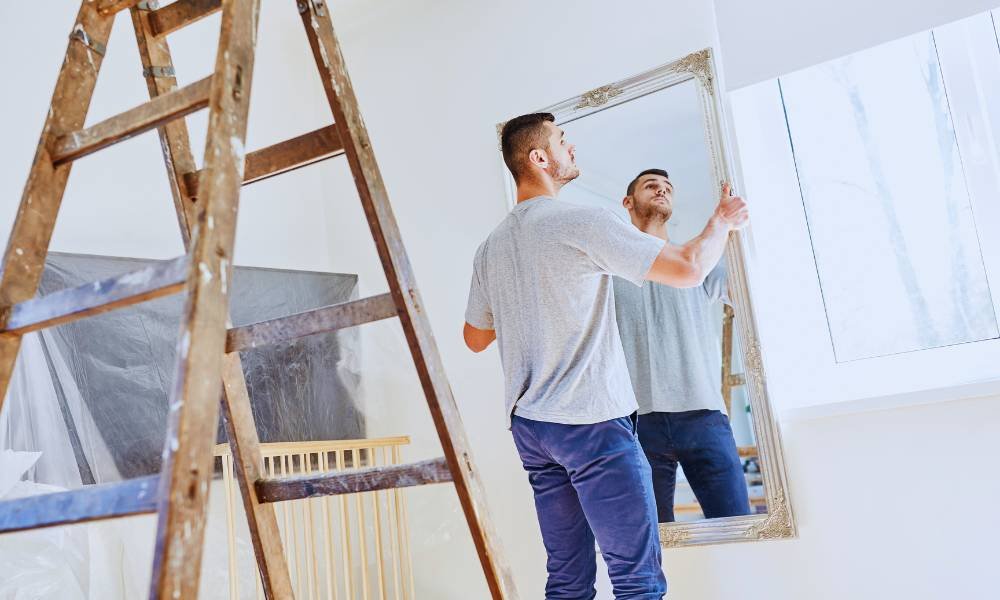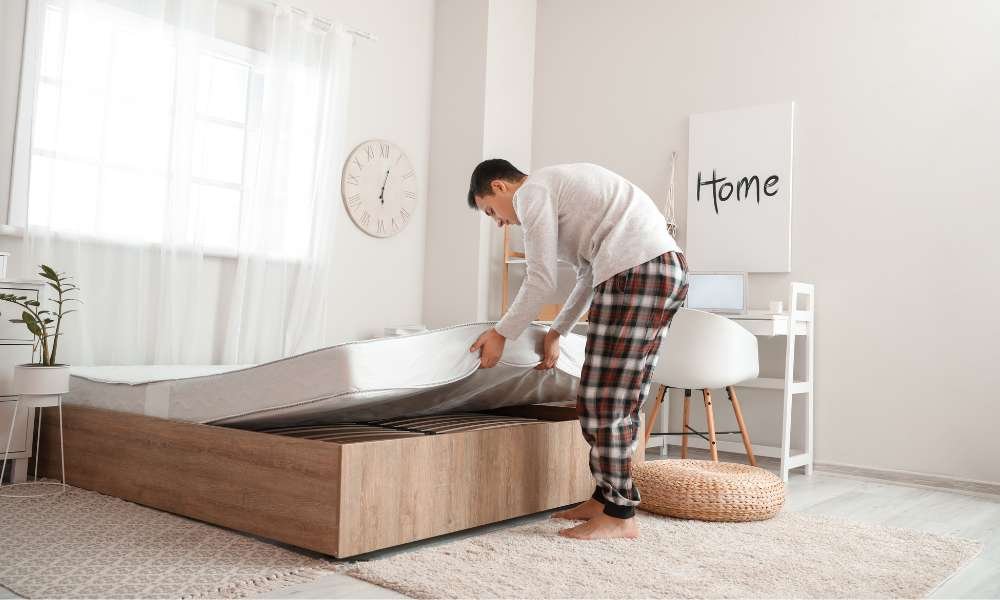A well-placed mirror can significantly enhance home décor, creating a sense of space, reflecting light, and adding a touch of elegance. Learning how to hang a long mirror on the wall is crucial for achieving these benefits. A long mirror serves as a functional piece and a stylish focal point, making any room appear larger and more inviting. Properly hanging a long mirror ensures it complements your interior design while staying securely in place. This guide will provide step-by-step instructions on how to hang a long mirror on the wall, highlighting its advantages and the importance of precise placement for optimal effect.
Choosing the Right Location
Choosing the right location for your long mirror is essential for maximizing its impact and functionality. Start by considering natural light sources; placing the reflector where it reflects daylight can brighten the room and enhance its ambiance. Evaluate the wall space and room aesthetics to ensure the mirror complements your décor and fits seamlessly into the space. Additionally, prioritize safety and practicality; make sure the chosen spot can support the mirror’s weight and avoid areas where it could be easily bumped or damaged. By carefully selecting the optimal location, you’ll ensure your long reflector not only looks great but also functions effectively in your home.
Measuring and Marking the Wall

Measuring and marking the wall accurately is key when learning how to hang a long mirror on the wall. Start by gathering essential tools: a measuring tape, pencil, and level. First, determine the ideal height and position for the mirror to ensure it complements your room’s layout. Use the measuring tape to find the precise location and the level to keep everything aligned. Mark the mounting points with a pencil to guide your installation. Proper measurement and marking are crucial for achieving a balanced and securely hung reflector, enhancing both functionality and style in your space.
Selecting the Right Hardware

When learning how to hang a long mirror on the wall, selecting the right hardware is crucial. Start by choosing wall anchors and screws that match the mirror’s weight and the wall type—drywall, plaster, or brick. For drywall, use plastic anchors; for plaster, toggle bolts are ideal; and for brick, masonry screws are necessary. Ensure the screws are long enough to provide secure support but not so long that they damage the wall. Properly matching the hardware to your partition type and the mirror’s weight will ensure a stable and safe installation, preventing any potential accidents and maintaining the mirror’s elegance in your space.
Preparing the Mirror
Preparing the mirror is essential when learning how to hang a long reflector on the wall. Start by cleaning the mirror thoroughly to remove any dust or smudges, ensuring it looks pristine once hung. Next, inspect the mirror for any damage that might affect its stability. Adding protective pads to the back of the reflector can prevent scratches and damage to your partition. Finally, securely attach the hanging hardware to the mirror frame according to the manufacturer’s instructions. This step ensures that your long reflector will be securely mounted, minimizing the risk of it shifting or falling once it’s on the wall.
Drilling Holes and Installing Anchors
When learning how to hang a long mirror on the wall, drilling holes and installing anchors correctly is key to a secure mount. First, choose the right drill bit based on your wall type—whether drywall, plaster, or brick. For drywall, a standard bit works, while masonry bits are needed for brick or concrete. Next, drill pilot holes at your marked points to ensure accuracy. Insert partition anchors into these holes, ensuring they fit snugly. This step is crucial for holding the weight of the long reflector and preventing damage to your wall. Properly installed anchors provide a stable foundation for your mirror, ensuring a professional and safe installation.
Attaching Mounting Brackets
When learning how to hang a long mirror on the wall, properly attaching mounting brackets is crucial. Start by positioning the brackets on the wall where you’ve marked the desired height. Use a level to ensure the brackets are perfectly aligned horizontally, as uneven brackets can cause the reflector to hang crooked. Secure the brackets to the partition with screws, making sure they are firmly anchored to support the mirror’s weight. Double-check that the brackets are level and aligned before proceeding. Properly attaching and aligning mounting brackets will ensure your reflector is securely hung and looks professional, enhancing your space effectively.
Hanging the Mirror

When hanging a long mirror on the wall, ensure you enlist help if the reflector is heavy to avoid any mishaps. Begin by aligning the mirror’s hardware with the wall brackets for a secure fit. Carefully lift the mirror and position it against the brackets, making sure it’s properly aligned. Securing the reflector in place requires a steady hand and attention to detail to prevent shifting or tilting. Proper alignment and careful handling are crucial for both the mirror’s safety and the overall aesthetic of your space. Following these steps ensures that your long reflector is hung securely and looks flawless on your wall.
Final Adjustments
After hanging your long mirror, it’s crucial to make final adjustments to ensure a perfect fit. Start by checking the alignment and level of the reflector to guarantee it hangs straight and complements your space. Use a level tool to confirm that the mirror is even. If needed, make minor adjustments to achieve a flawless look. Ensure the reflector is securely attached by double-checking all mounting hardware and supports. This step prevents any potential shifting or instability, keeping your mirror safely in place. Proper final adjustments are key to a well-hung reflector, blending seamlessly into your home décor.
Safety Tips and Maintenance
Ensuring the safety and longevity of your long mirror involves a few key practices. Regularly check the mirror’s stability to prevent accidents and ensure it remains securely mounted. For maintenance, clean the reflector with a soft, lint-free cloth and a gentle glass cleaner to keep it spotless and gleaming. Avoid abrasive materials that can damage the surface. When dealing with heavy or large mirrors, use appropriate wall anchors and hardware to support the weight and prevent damage to your walls. Following these safety tips and maintenance practices will help you enjoy the benefits of your long reflector for years to come while keeping your home safe and stylish.
Conclusion
In conclusion, mastering how to hang a long mirror on the wall involves careful measurement, selecting the right hardware, and ensuring proper installation for both style and stability. By following these steps—choosing the perfect location, preparing the mirror, and securely mounting it—you can achieve a polished look that elevates your space. Don’t hesitate to add personal touches like decorative frames or unique placement to make the reflector a standout feature in your home. Mirrors not only enhance your décor but also create a more open and inviting atmosphere. Embrace these tips to transform your room with a beautifully hung long mirror.
FAQs for How to Hang Long Mirror on Wall
What tools do I need to hang a long mirror on the wall?
You’ll need a measuring tape, pencil, level, drill, wall anchors, screws, and possibly a stud finder depending on your partition type.
How do I determine the best height for hanging a long mirror?
Measure from the floor to the center of the reflector, aiming for eye level. For full-length mirrors, align the bottom edge a few inches above the floor.
Can I hang a long mirror on drywall?
Yes, but you’ll need to use wall anchors or screws designed for drywall to ensure the mirror stays securely in place.
How do I ensure my mirror is level after hanging?
Use a level to check alignment both horizontally and vertically before securing the mirror completely.
What should I do if my mirror is too heavy for standard wall anchors?
If the mirror is too heavy, use wall anchors designed for heavier loads, or consider installing a wooden cleat system for additional support.



